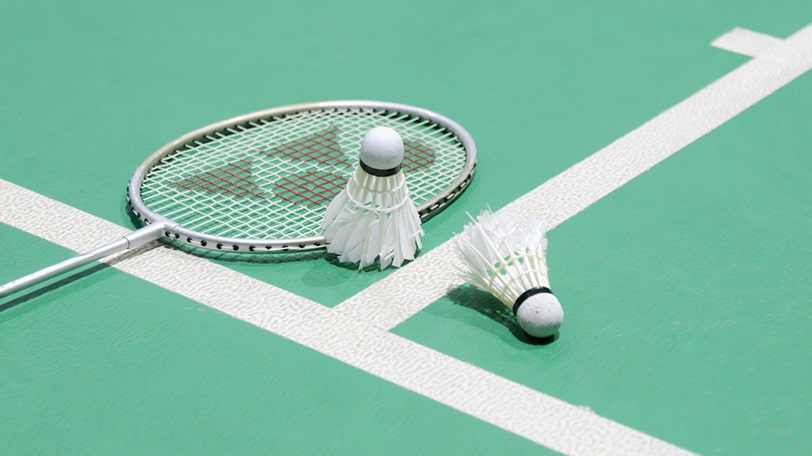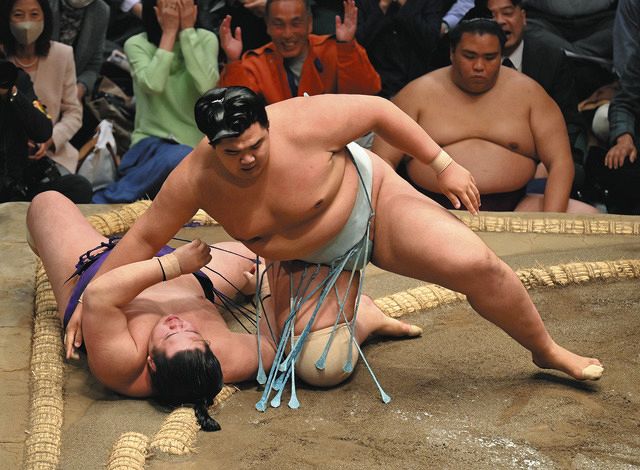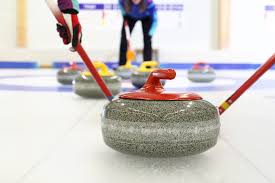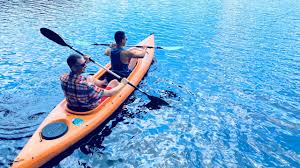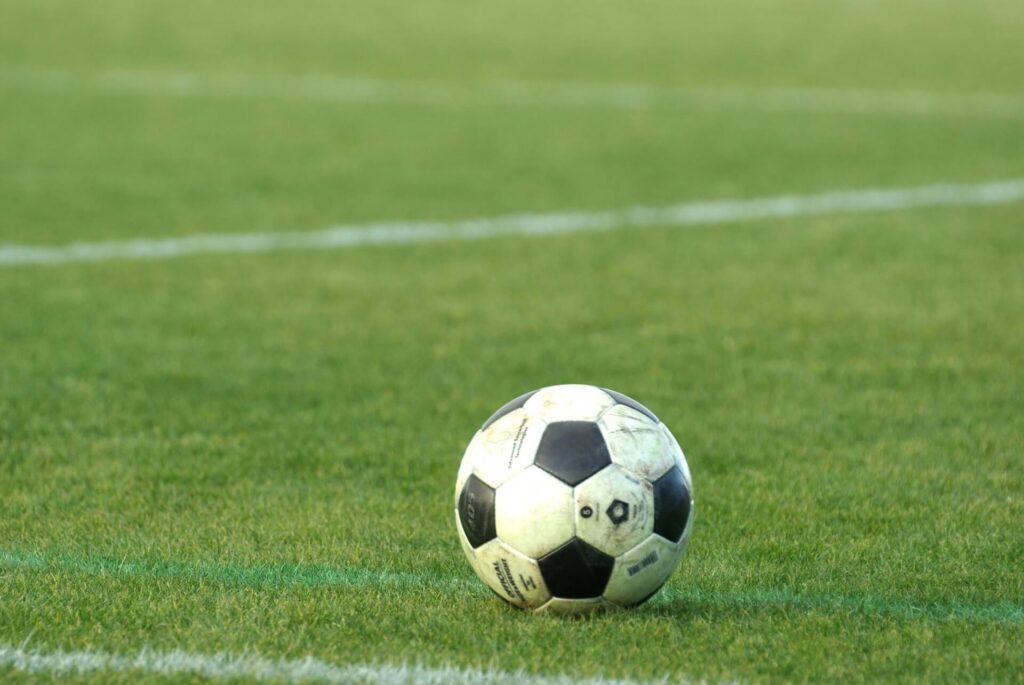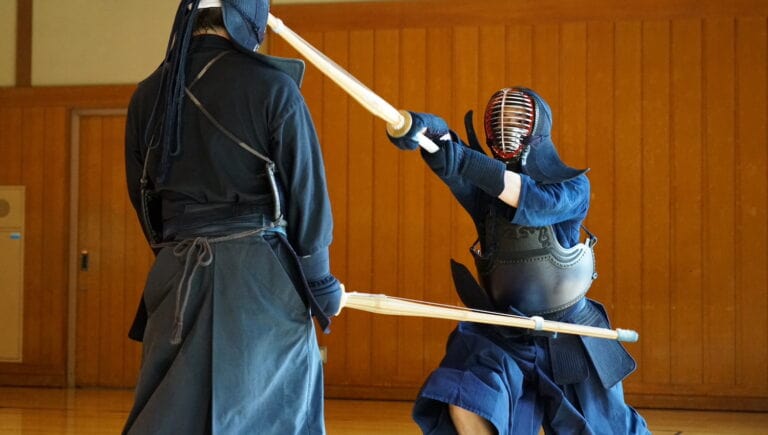
目次
- 1 Kendo glossary
- 1.1 Aiuchi
- 1.2 Aiigamae
- 1.3 Aiki
- 1.4 Ainuke
- 1.5 Aun’s breathing
- 1.6 Agekote
- 1.7 Foot problems
- 1.8 Foot handling
- 1.9 surplus
- 1.10 Stepping foot (Ayumiashi)
- 1.11 One eye, two feet, three gall, four powers
- 1.12 Between one foot and one sword
- 1.13 settle down
- 1.14 Itto Ryu
- 1.15 The word “inasu”
- 1.16 color
- 1.17 Yin
- 1.18 typing practice
- 1.19 Uchikomi Jutoku
- 1.20 response technique
- 1.21 Okuriashi
- 1.22 obi rectangle (obinokane)
- 1.23 Front and back
- 1.24 return technique
- 1.25 Kari Keiko
- 1.26 shout
- 1.27 Living sword (katsuninken)
- 1.28 Katori/Kashima
- 1.29 Three places at the bottom (turnip)
- 1.30 Kamae
- 1.31 lower stance
- 1.32 Jodan no kamae (jodan no kamae)
- 1.33 Wakigamae
- 1.34 Hasso no Kamae
- 1.35 Kamiza
- 1.36 Kanken no Metsuke (Kanken no Metsuke)
- 1.37 spirit (kiai)
- 1.38 kitori (kiatari)
- 1.39 Kigura (Kigura)
- 1.40 Kiken Tai no Ichi
- 1.41 Before the plane
- 1.42 notice
- 1.43 Giheki
- 1.44 Kirikaeshi
- 1.45 Kirikaeshi Hattoku
- 1.46 Falsehood (Kyojitsu)
- 1.47 Kumiuchi
- 1.48 Kumitachi
- 1.49 practice (keiko)
- 1.50 Kenshin Ichinyo
- 1.51 The philosophy of Kendo (Kendo Norinen)
- 1.52 Ken no Gotoku (sword trivet)
- 1.53 Kendo style
- 1.54 Purpose of Kendo training
- 1.55 Kendo philosophy
- 1.56 Waiting match (Kentaiichi)
- 1.57 “The sword is the heart” (Ken wa Kokoronari)
- 1.58 step on the sword
- 1.59 council (gougi)
- 1.60 Kouken Chiai
- 1.61 Fox suspicion
- 1.62 Clear
- 1.63 Sword posture
- 1.64 Stitching surface
- 1.65 Triangular stance
- 1.66 Three successes
- 1.67 Three kills
- 1.68 Zanshin
- 1.69 Sanma-no-dori (sanma-no-dori)
- 1.70 Jikishin Kore Dojo
- 1.71 Four precepts
- 1.72 trick
- 1.73 Jigeiko
- 1.74 Stopping (stopping)
- 1.75 Stretching competition
- 1.76 Shinogi
- 1.77 Shuhari
- 1.78 Consistency of mind, spirit, and energy (shinkiryokuichi)
- 1.79 gap
- 1.80 Surrender (Sutemi)
- 1.81 Suburi
- 1.82 Seigan no Kamae (Seigan no Kamae)
- 1.83 Dynamics in stillness
- 1.84 Sekka-no-ki
- 1.85 Murder sword (Setsuninto)
- 1.86 “Ahead”
- 1.87 offset
- 1.88 crouching
- 1.89 Body hit (Taitori)
- 1.90 Daikyōsokukei
- 1.91 Opportunity for striking
- 1.92 For
- 1.93 Tanden
- 1.94 Chijinyuu
- 1.95 Tip of the pair (Tsuinosen)
- 1.96 Chudan stance
- 1.97 Tsugiashi
- 1.98 attach (attach)
- 1.99 Tsubazeriai
- 1.100 within the hands
- 1.101 Stillness in motion (because of Dochu)
- 1.102 Take a Chinese ink (take a Chinese ink)
- 1.103 Blade line (hasuji)
- 1.104 Hasso no Kamae
- 1.105 Hikagami
- 1.106 pull up
- 1.107 Hyakurenjitoku
- 1.108 Hirauchi
- 1.109 Open legs (Hirakiashi)
- 1.110 Two measurements (two measurements)
- 1.111 Stepping foot (Fumikomiashi)
- 1.112 Ordinary mind/Fudoshin
- 1.113 absentmindedness
- 1.114 Mae and mai (cohesiveness)
- 1.115 Pillow support (Pillow support)
- 1.116 Watching practice (Keiko Mitori)
- 1.117 Mushin
- 1.118 Regret, Musou
- 1.119 Meikyo Shisui
- 1.120 Weight (metsuke)
- 1.121 meditation
- 1.122 Monouchi (monouchi)
- 1.123 Effective strike (Yukou Datsu)
- 1.124 It doesn’t matter what you want
- 1.125 The meaning of gratitude
- 1.126 Rigyoichi
- 1.127 side stance
- 2 At the end
Kendo glossary
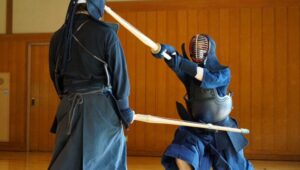
men! Do! Trowel!
Kendo, like fencing, is a sport that imitates swordsmanship.
The style is Japanese swordsmanship, and is performed using a bamboo sword that imitates a sword.
In Japan, Kendo is also adopted as a junior high school club activity.
Few Japanese people know the rules, names of techniques, or terminology used in Kendo.
Here, we will introduce the basic terminology of Kendo.
For those who want to experience traditional Japanese culture or those who are about to start Kendo.
Please use the Kendo glossary on this page to learn more about Kendo.
Aiuchi
It has the same meaning as the commonly used trade-off.
If both players perform the same valid strikes at the same time in a match or practice, both players will not be considered valid strikes.
Aiigamae
It is performed in aichudan or aijodan by taking the same stance as the opponent.
Kendo is a sport where tactics are important. Use your head to win!
Aiki
It refers to a situation where both sides are attacking and defending at the same time, and there is no way to win or lose.
Also, when Aiki is removed, both sides become aggressive and defensive at the same time, and when there is no winner or loser, this refers to changing the previous tactics and attacking.
(This is different from Aiki, the Japanese traditional martial art)
Ainuke
It shows that you don’t want to fight with each other or that you won’t fight each other.
Please try your best in the Kendo match.
Aun’s breathing
It refers to synchronizing the breath with the other person, with “A” symbolizing exhalation and “Un” representing inhalation, representing the resources and ultimate nature of all things.
Agekote
This is a technique in which the opponent raises his hand to take a high stance, and refers to when the left fist is raised above the hato at the time of the strike.
This is commonly referred to as Mock Kote, and due to the revision of the regulations that made the left hand Kote an effective Uchitsu, “Age Kote” was specifically specified.
Foot problems
This refers to stepping on or entangling an opponent, and is considered a foul in matches.
In the past, it was frequently practiced in practice and was considered a technique.
Foot handling
Refers to the method of moving the feet (footwork) in Kendo.
There are various types such as walking foot, sending foot, opening foot, and connecting foot, and these are used to adjust the distance to the opponent and when attacking.
surplus
It refers to skillfully dodging the opponent’s attacks and moving the body from behind to get past the attack.
Stepping foot (Ayumiashi)
Similar to walking in everyday life, this is a step in which you alternately put your feet in front of you, and is used to adjust the distance to your opponent.
One eye, two feet, three gall, four powers
Showing the elements of kendo training, single eye refers to the ability to see through the opponent’s thoughts and actions, two feet refers to the use of the feet, which is the basis of techniques, three cho refers to courage and decisiveness, and four powers refers to the power of technique.
Between one foot and one sword
Usually, it refers to the sense of distance as whether the tip of the sword touches or does not touch. This means that if you take one step forward, you can inflict a strike on your opponent, and if you take a step back, you can dodge the opponent’s strike.
If the distance is closer than this, it is called near, and if it is farther than this, it is called far.
However, this sense of distance cannot be determined unconditionally depending on the individual’s physical strength, body shape, muscular strength, and Kendo proficiency.
Let’s hone this sense of mai through practice.
settle down
This refers to a state in which you are temporarily unable to move during an attack or defense, or a state in which your mind temporarily stops and you are unable to make a momentary movement.
For example, if you grip your Shinai too tightly, or if your body’s center of gravity tilts backwards and you are unable to move forward, this is said to be the case.
Itto Ryu
It is a style that mainly uses a single sword, and includes Ono-ha Itto-ryu and Hokushin Itto-ryu.
The word “inasu”
This refers to parrying the opponent’s blows while at the same time breaking the opponent’s stance.
color
It means the falsehood of truth. When the opponent has no chance, it refers to luring the opponent by showing falsehood through one’s movements.
For example, there is a technique where you indicate that you intend to hit your opponent on the face, and then strike a small hand the moment the opponent raises their hand to block the attack.
Yin
It is a word for positive, and refers to the back side of the front side. It can also refer to the right side of the body.
typing practice
This is a basic training method in which you decide in advance where to strike and then strike into the gap between your opponents.
This will be basic training for Kendo.
Uchikomi Jutoku
It refers to the following 10 virtues:
To move violently and quickly.
The blow becomes stronger.
Breathing becomes longer.
freedom of arm movement.
To feel light and free.
Ability to freely handle a long sword.
Do not let your body slump below the navel.
That the eyes become clear.
The gaps between the strokes should become clear.
Feeling slightly clear inside your hands.
Toyama’s Metsuke (Enzan’s Metsuke)
This is a teaching that when facing an opponent, one should not just look at one place, such as the opponent’s bamboo sword or the striking part, but instead look at the opponent’s entire body, centering on the opponent’s face, as if looking at a mountain in the distance.
response technique
A technique that nullifies the opponent’s attack by using techniques such as “slipping up,” “returning,” “pucking,” and “striking down” against the opponent’s attack, and at the same time uses the created gap to strike. It refers to things.
Okuriashi
This is the most basic type of foot movement, where you start the movement with the foot in the direction you are moving, then move your other foot and pull it towards the foot you are moving towards.
Beginners should learn footwork from Okuriashi
obi rectangle (obinokane)
This is a teaching that if you are at risk of being read into someone’s mind by looking into their eyes, you should look at the area around their obi.
It is said that if you can see your opponent’s eyes, it is difficult to read your mind, making it difficult to make bold attacks. It is also called “Wakimezuke”.
Front and back
When held in the middle position, the left side of your shinai is called your front side, and the right side is called your back side.
This phrase comes from the fact that when a sword is worn on the waist, the side that is closest to the body is the back side, and the side that is on the outside is the front side.
return technique
This is a technique in which you turn your wrist in response to the opponent’s shinai and strike the other side of the shinai.
This is a skill that is naturally acquired by intermediate players and above. Practice and be able to do it!
Kari Keiko
It is a practice in which you perform various techniques with sufficient energy and physical strength based on your own will, without being bound by the opponent’s attacks or actions.
Motodachi promotes good striking, avoids forced attacks and ineffective strikes, and teaches accurate striking and spirit.
Kakari practice improves agility and stamina, improves teuuchi and te kaeshi, understands correct mai, and recognizes opportunities to strike.
shout
In Kendo, by making a loud noise, you can motivate yourself, raise your spirits, dispel fear, and attack.
In addition, by causing surprise and fear in the opponent and putting them in a state of no-mind, it promotes unity of mind and energy, and by making a sound at the moment of striking, it becomes possible to strike swiftly, strongly, and clearly.
Living sword (katsuninken)
It refers to winning without scooping the enemy, and in Shinkage-ryu it is considered the basis of all jutsu.
Katori/Kashima
Katori Jingu and Kashima Jingu are both revered as shrines dedicated to the god of war, and are considered the birthplace of martial arts.
Three places at the bottom (turnip)
This word refers to the importance of moving your feet, especially the use of hikagami on the backs of your feet, hips, and knees.
Kamae
The middle stance is called the “jo no katae” or the “seigen no kame” and is considered the most convenient and ideal stance for offense and defense.
Point the shinai at the center of your opponent, from a natural position, put your right foot in front of you, place your left foot in front of your navel, and extend your fist about one inch forward.
lower stance
It is said to be a “defensive stance” and can be used to respond to enemies from all directions.
Lower the shinai from the middle stance so that the extension of the tip of the sword points toward the middle of the opponent’s knees.
Jodan no kamae (jodan no kamae)
It is also called the “fire stance” and is the most offensive stance.
In this stance, you control the beginning of your opponent’s technique with just your head and hold the Shinai with an aggressive attitude.
From a middle stance, raise the shinai above your head so that your arms form a triangle in front of your face. There are two hands and one hand on the upper left and upper right.
Wakigamae
Also called “Yo no kame”, this is a stance that allows you to use the Shinai differently depending on the opponent’s movements.
From the Chudan stance, take a step back with your right foot, draw your hand to your right side, lower the tip of the Shinai slightly below the horizontal, and hide the tip of the sword behind your body so that your opponent cannot see it.
Hasso no Kamae
Also known as the “shadow stance,” this is a stance in which you do not launch an attack yourself, but instead move based on the opponent’s stance.
From Chudan stance, take a step with your left foot and place your left fist in front of your right nipple and your right fist at the level of your mouth. It is called “Hasso” because the drawn sword and sheath form a figure eight.
It is also said to be “quick to attack” because it can instantly respond to enemies from all directions.
Kamiza
This is the upper seat of the dojo, and when a household altar is placed, the center of the front is called the “shonchu” and is considered the most honorable position.
The left side is the top and the right is the next, and the sitting direction is based on Chinese tradition, facing south, with the east being the top and the west being the bottom.
Kanken no Metsuke (Kanken no Metsuke)
Refers to the eye for insight and physical movement. It is important to look into the other person’s eyes; it is said that the eyes are the mirror of the soul, and you can understand the other person’s state of mind.
By looking into the other person’s eyes, you can see the whole person, and the importance of seeing the other person with your heart is emphasized.
spirit (kiai)
It refers to approaching a task with full energy, concentration, and attentiveness.
There are two types of kiai: voiced and unvoiced, and both must be able to attack immediately without leaving any openings to the opponent.
Kiai is very important in Kendo, and a high state of Kiai is essential to defeating your opponent.
Let’s raise our spirits from everyday life.
kitori (kiatari)
It refers to the act of energizing the other person in a meeting and observing the other person’s success and reactions.
In the real world, you can’t defeat your opponent just by thinking like in manga!
Kigura (Kigura)
It refers to the inviolable dignity that one possesses as a result of years of training and skill training.
Kiken Tai no Ichi
In the standards of striking, “ki” refers to the will to attack and the spirit and shouts that express it, “ken” refers to the correct handling of the bamboo sword, and “tai” refers to body movements, posture, and movements involving the legs and hips. .
The condition for effective striking is that these conditions are met at the same time. This is different from concord of mind and spirit.
Before the plane
This refers to taking advantage of the opponent’s ideas and demoralizing them before they can express their thoughts.
notice
This means preparing yourself before the meeting.
It is sometimes said that some of the great matches in martial arts history were decided before the match was even witnessed.
Giheki
This is a technical quirk that each person has, and this is the cause of hindering their progress.
Correcting your technique habits is important in order to understand and master the correct techniques.
Kirikaeshi
It is a comprehensive Kendo training method that usually repeats front strike → body strike → continuous left and right sides → front strike twice.
The five rules for cutting back are:
① Big and correct
② Maintain the correct distance
③The fist of the left hand is always in the center of the body and the right hand is extended.
④Don’t control yourself with your body
⑤The principle is to use the return of the sword to strike.
Kirikaeshi Hattoku
This is a Kendo training method that includes the following eight virtues.
It becomes a blow that matches the spirit, sword, and body.
Eliminate unnecessary power and correct bad habits
Have the correct posture
Builds endurance and allows you to breathe longer
My eyes are bright and I remember the distance.
Improve your physical strength and strengthen your legs and hips
Become energetic
The return of the sword improves
Falsehood (Kyojitsu)
This refers to the state in which the opponent’s defense is weak (false) and the state in which it is strong (real), and it is important to avoid the real and hit the false.
The opponent’s truth and falsehood will change depending on how you attack, and it is important to be able to identify the changes and attack.
Kumiuchi
Although it is prohibited in modern Kendo, in the past, when an opponent dropped a Shinai sword or when there was a tsubame clash, foot-locking and grappling were used.
Kumitachi
This is a form created by a master to teach his disciples various ways to defeat their opponents.
practice (keiko)
It is a traditional Japanese martial arts and art practice method that means looking back on the old.
(I said it in a difficult way, but to put it simply, it’s the same as training for other sports)
Kenshin Ichinyo
As the saying goes, “The sword is the person, and the sword is the mind,” which means that the sword is moved by the mind, and that the sword and the mind are one thing.
It is said that one can hone one’s right mind through sword training.
The philosophy of Kendo (Kendo Norinen)
Kendo is defined as “Kendo is a way of forming a person through the training of the principles of the sword.”
Ken no Gotoku (sword trivet)
It represents justice, shame, courage, courtesy, and humility.
Kendo style
It compiles the outstanding techniques of each school and assembles the most basic striking method of Kendo techniques.
Etiquette, stance, distance, attack, blow, spirit, zanshin, etc., all of which can be called techniques, are extremely advanced.
It is important for beginners as well as advanced practitioners to constantly practice kata. The effects of shape include:
Learning correct posture and calm demeanor
Ability to observe others with bright eyes
Improving bad habits and developing accurate sword skills
Training of spirit and fulfilling spirit
Agile and light movement
Understanding proper spacing
Achieving reliable blows
Kendo training mindset
“Study kendo properly and seriously, train your mind and body, cultivate a strong will, and through the characteristics of kendo, respect etiquette, respect faith, be sincere, always strive for self-cultivation, and thereby contribute to the nation and society.” We love them and strive to contribute to the peace and prosperity of humanity.”
Purpose of Kendo training
The goal is to develop one’s character through training in the principles of the sword, and to train one’s mind and body to cultivate an excellent mind, a strong body, and a noble personality.
Kendo philosophy
“Kendo is a way of forming a person through training in the principles of the sword.”
Character development is the path in Kendo! Train your mind by practicing hard.
Waiting match (Kentaiichi)
“Even if you focus only on attacking, or only on preparing, there will be gaps.
Therefore, in addition to having a strong will, we must have a spirit of waiting when something is at stake, and a spirit of concern when waiting.” This teaching is also called “the unity of offense and defense.”
“The sword is the heart” (Ken wa Kokoronari)
The sword is the person himself, and if the heart is not right, the sword is also not right, and it is preached that it is important to first correct the mind in order to learn how to use the sword.
step on the sword
This word comes from Miyamoto Musashi’s “The Book of Five Rings,” and refers to taking the initiative by being prepared to step on the opponent’s sword with your foot.
At this time, the key is to control with your mind, your body, and your sword to control the tip of your opponent’s sword.
council (gougi)
This refers to the referees consulting with each other when they discover a foul by a player or when they have doubts.
Kouken Chiai
It has the meaning of knowing how to love by crossing swords.
Kendo is not just about hitting each other with bamboo sticks, but it also represents the spirit of mutual respect and mutual growth through practicing together.
Fox suspicion
Foxes are suspicious animals and sometimes get lost because they have no way to escape, and this refers to such a state.
In Kendo, we caution against doubts arising from not being able to decide whether to advance or retreat, and encourage a dignified attitude and mental determination.
Clear
It refers to excellent technical movement, and is referred to as “smart technique” or “smart hitting.”
This clear movement represents a rational and lean state, and is a scientifically intuitive expression of movement in which energy is used most effectively.
Therefore, if you make a lot of unnecessary strokes and unnecessary movements, you cannot say that you are doing well.
When holding a stance, it is necessary to relax, tense the muscles necessary at the moment of striking, and move the body and spirit in unison.
Sword posture
This refers to the posture when performing a standing ceremony with your arms outstretched and holding a sword, wooden sword, or shinai in your left hand.
Stitching surface
This is a technique in which the pommel of the shinai is raised with the left hand, and the shinai is placed over the opponent’s head with the right hand.
Triangular stance
This means holding the sword in the middle position without disturbing the triangular rectangle of the eyes, belly, and tip of the sword.
This teaching was developed by Tesshu Yamaoka.
Three successes
It is important that the three tools (kissai, body, and spirit) necessary to perform techniques to attack the opponent are in harmony, and this can only be achieved through training.
Three kills
It refers to the three elements of “killing the spirit,” “killing the bamboo sword/tachi,” and “killing the technique.”
Killing Ki refers to attacking by breaking the opponent’s Ki with full energy, killing the Shinai means controlling the opponent’s Shinai, and killing technique means to attack by getting ahead of the opponent’s movements. It means not giving.
Shusaku Chiba describes this as “three setbacks.”
Zanshin
It refers to the state of mind that allows you to remain calm and alert even after striking your opponent, and to be able to quickly respond to changes.
Usually this means returning to a mid-dan stance after a strike and facing the opponent directly.
Sanma-no-dori (sanma-no-dori)
In Kendo, the three elements of learning, training, and ingenuity are important, and it refers to the integrated refinement of these elements.
Jikishin Kore Dojo
This means learning kendo with a pure, innocent and honest heart, thinking about everyday life events other than kendo from a kendo perspective, and practicing without leaving kendo under any circumstances.
Four precepts
These are the four commandments of Kendo, which refer to “shock”, “shock”, “doubt”, and “perplexity”.
Surprise indicates being shaken by a sudden and unexpected situation, fear indicates physical and mental rigidity due to fear, doubt indicates stagnation of attention due to doubt, and confusion indicates confusion that prevents accurate judgment and action.
Training is necessary to avoid these mental disturbances.
trick
This is a technique in which you attack the center yourself before the opponent makes a striking movement, or strike while finding an opening in the opponent.
Jigeiko
It is a comprehensive training method in which both participants actively present techniques that enrich their energy and train each other.
Stopping (stopping)
This refers to a state in which one’s attention is stopped on one thing, also known as “attending,” and it is a state of mind in which one is easily attacked by the other person.
Stretching competition
At a time when kendo was banned by GHQ after the war, Junzo Sasamori and others proposed a sport-style competition similar to fencing, and with the permission of GHQ, the All-Japan Kendo Federation was formed in 1954.
The All Japan Kendo Federation was founded in 1955, but it continued until the early 1950s.
Shinogi
It refers to the ridgeline that is one step higher from the mine/mune of the sword toward the blade.
Both the ridge and the ridge refer to the same place, on opposite sides of the blade. This is expressed in period dramas as “mineuchi,” which means to strike with the opposite side of the blade.
By the way, you cannot do mine-uchi with the bamboo sword used in kendo.
Shuhari
It is a word that refers to the process of training, and “shu” refers to the stage in which one strictly follows the teacher’s teachings and thoroughly masters the basics.
Ha is based on previous teachings, but refers to the stage where you make use of your own individuality and create something unique, and ri is a stage where you do not depart from the original teachings, but act freely with them as the core, and continue to teach. refers to the stage of transcending.
Consistency of mind, spirit, and energy (shinkiryokuichi)
“Kokoro” is the power of observation (the ability to understand the other person’s mental movements, the mind’s eye), fudoshin (a calm mind that is not distracted by the other person’s movements, a calm mind), and “ki” is the ability to concentrate (concentrating mental energy). “Power” includes “force” (the power to overwhelm the opponent with your energy and control their mental and physical movements), “power” includes explosive power (the ability to quickly respond to changes in the opponent), and intelligence (to lead the battle to an advantage) wisdom) means to be in agreement.
gap
It refers to gaps in the mind that are caused by surprise, fear, doubt, or confusion, or gaps in movement or stance where the tip of the sword moves away from the opponent’s center or the hand moves up and down.
Surrender (Sutemi)
Opportunities emerge for the first time by sacrificing yourself, and if you find an opening in your opponent, you can win by sacrificing yourself and attacking without hesitation.
Suburi
This is the movement of holding a shinai or wooden sword and swinging it widely and accurately up and down or diagonally, and is done to understand the operation of a shinai, the line of the blade, and to establish the basics of striking.
Seigan no Kamae (Seigan no Kamae)
It is one of the middle stances, and has different names depending on the position of the tip of the sword.
Seigan places the tip of the sword in the opponent’s throat, clear eyes puts the tip between the eyes, blue eyes puts the tip of the sword in the opponent’s left eye, star eyes puts the tip of the sword in the center of the opponent’s face, and navel puts the tip of the sword in the opponent’s navel. Refers to stance.
Dynamics in stillness
It is important to be mentally prepared to not stagnate while quietly observing the other person, and to be able to move into vigorous action at the moment when the opportunity is ripe; this means that the mind remains calm even in the midst of movement. This shows the opposite of the teaching.
Sekka-no-ki
This is a teaching described in Fudo Chijin Myoroku, a work written by Osho Takuan, and just like a spark is emitted at the moment a flint is struck, it appears instantaneously at the moment of striking, and there are no gaps or margins in time. means that it does not exist. It teaches that there is no place for the mind to dwell, and that the mind should not dwell on it.
Murder sword (Setsuninto)
In Yagyu Sekishusai Sogon’s Kusatsu Koan sho, it says, “All swords held by our school are called murder swords.”
This means that every sword that is held has the effect of killing or injuring the enemy, and a place where there is no stance is called a living sword.
The purpose of killing is to control the opponent and gain victory by cutting the long sword held at the ready and making use of the missing parts.
“Ahead”
There are three types of “destination”.
Saki no saki (saki no saki) refers to anticipating the opponent’s thoughts and hitting them before they make a move.
Although it is not possible to read the opponent’s intentions, tai no saki (saki, sakimae no saki) refers to making the first move before the opponent’s technique has a chance to produce results.
Go no saki (machi no saki, saki no saki) refers to dodging or counterattacking the opponent’s technique in response to the opponent’s “saki”.
offset
This refers to subtracting contradictory things such as loans, loans, losses, and profits to zero, and refers to the fact that when both sides commit two fouls at the same time in a match and both lose, the second foul is not counted as a foul.
crouching
When used in Kendo, it refers to a natural posture with the right foot slightly forward, standing on tiptoe, with both knees bent to the left and right, and upper body straight.
It is originally a type of etiquette, and includes standing bow, sitting bow, and kneeling bow. The kneeling bow is performed outdoors when bowing to a superior is impolite, and sitting bowing is also difficult.
Body hit (Taitori)
It is an action to demoralize the opponent, break his balance, and strike the moment the opponent loses his stance, and is not done with the sole purpose of defeating the opponent.
Therefore, it is important to concentrate the momentum of the step into the lower abdomen, cross the handles of the shinai, and hit with the hips.Pushing with the arms or thrusting from the head is not called taimari. No.
Taking the plunge and ramming into your opponent is also a tactic.
Daikyōsokukei
This is the key to teaching beginners, and based on the principle of “big and correct,” the technique begins with hitting big and hitting hard and accurately.The speed of the techniques gradually increases, eliminating wasted force, and gradually making kendo more agile and clear. It shows the process of evolution.
Opportunity for striking
It refers to the appropriate opportunity to strike, and indicates a good opportunity to strike by taking advantage of various situations, such as the moment the opponent strikes, the moment the opponent catches the opponent, the moment the opponent retreats, or the moment the opponent runs out of techniques.
In particular, the places where things occur, where they are accepted, and where they settle are also called the “three unforgiving places.”
For
When performing a technique, it is important to have a relaxed mind and body, to enrich your qi, and to concentrate your qi on the lower umbilical tanden before performing the technique.
Techniques that are released from a state of lack of energy can be easily read by the opponent, so it is necessary to practice them thoroughly.
Tanden
It is called the lower umbilical dantian, and is located in the abdomen between the navel and pubic bone, and is the place where Qi, the source of physical and mental vitality, gathers.
It is said that by putting pressure on this area, you can maintain a seated posture and suppress your mental agitation.
By the way, there is also a breathing method used for meditation called Tanda Breathing. It is a place of deep connection with mental stability.
Chijinyuu
It is an important concept in the way of swordsmanship, and it is a harmonious combination of “Wisdom”, which is the will to know what is right, “Jin”, which is the understanding and compassion of others, and “Yu”, which is the act of demonstrating courage and dedication. What became known as Ken no Michi.
Tip of the pair (Tsuinosen)
At the moment when the other person takes the initiative and makes a move, it also refers to making the first move.
Chudan stance
Known as “Jo no kamae” and “Seigan no kame”, it is considered the most convenient and ideal stance for offense and defense.
Point the tip of the sword toward the center of your opponent, and from a natural position, put your right foot forward, and place your left foot in front of your navel, about the width of a clenched fist.
This is an orthodox stance in modern Kendo.
Tsugiashi
This is a foot movement in which the back foot is drawn toward the front foot and the front foot moves forward, and is used to skillfully close the gap and take a big step when the opponent is too far away to reach the opponent.
attach (attach)
It refers to pointing the tip of the sword in a specific direction to control the opponent’s movements or prepare a posture to respond accurately to attacks.
Tsubazeriai
This refers to the state in which both players are at their closest distance to their opponent, with their Shinai held slightly diagonally to the right, and their tsuba (right fists) touching each other.
within the hands
It is sometimes referred to as the way to grip a shinai, but here it refers to the movements in the palm of the hand to effectively manipulate the shinai.
Specifically, it comprehensively covers how to hold the handle with the left and right hands, how to use the power of the left and right hands, the state of tension in both hands during a strike and its balance, and how to release the force after a strike. Point to.
Stillness in motion (because of Dochu)
It represents the lesson that it is important to calmly assess the opponent’s situation even in a fierce battle.
Take a Chinese ink (take a Chinese ink)
It comes from the word “Chuboku” used in carpenter’s terminology, and in Kendo it refers to the center of the opponent.
In other words, it means making sure that the tip of your sword does not deviate from the center of your opponent. It is important to always be aware of the opponent’s center and to not let the tip of the sword deviate to the left or right and not lose your stance.
When being struck by an opponent, the tip of the sword may shift to the left or right, creating an opening.
If you always try to keep the tip of your sword away from the center of your opponent, you will avoid getting hit, and even if you do get hit, you will be able to practice well.
Blade line (hasuji)
When cutting something, it is important that the direction of force applied matches the direction of the blade.
Even in Kendo, when striking, the blade is always manipulated accurately, and this is expressed as “bajiji tadate.”
On the other hand, when hammering flat, etc., it is said that the blade does not stand up or the blade line collapses.
Hasso no Kamae
Also called a “shadow stance,” it is a stance that changes into an attack depending on the opponent’s stance, rather than launching an attack itself.
From Chudan stance, take a step with your left foot, point the blade toward your opponent, place your left fist in front of your solar plexus, and place your right fist in front of your right shoulder so that the tsuba is at the level of your mouth.
Hikagami
The term refers to the back side of the knee, and the tension and amount of leeway in the left leg, as well as how to use it, are important for accurate footwork and stepping.
pull up
This refers to the act of withdrawing from the opponent and cutting off the opponent without proper posture or preparation after a strike.
Hyakurenjitoku
It is an ancient teaching that performing arts cannot be learned by seeing and hearing everything, but only becomes one’s own through repeated experiences of failure and success, and that constant effort is important.
Hirauchi
This refers to the way the Shinai is struck with the left or right side of the sword, but the blade is not aligned correctly.
Open legs (Hirakiashi)
Refers to the movement of the legs that moves the body from side to side in order to dodge the opponent’s strikes.
Two measurements (two measurements)
It is a teaching on how to use your eyes when looking at your opponent, with a particular emphasis on paying attention not only to your opponent’s eyes, but also to the point of your fists and sword.
However, it is said that this should not be taught to beginners, as focusing on a specific location can lead to “stopping”.
Stepping foot (Fumikomiashi)
This is a foot handling technique used when striking sharply without overlooking the opponent’s openings.
Take a kick with your left foot, then raise your right foot and press the entire sole of your foot into the floor.
Then, quickly pull your left foot towards you and smoothly move your left foot forward without losing your posture.
Ordinary mind/Fudoshin
It is a concept related to the state of mind, and the stability of the normal mind is called normal mind.
Also, a state of mind that does not waver under any circumstances is expressed as a steadfast heart. Maintaining a calm mind in any situation is important to demonstrating your abilities.
absentmindedness
Normally, it refers to a state of being absent-minded and disorganized, but in Kendo, it refers to a state of mind that is open-minded and unrestricted, so that you can flexibly deal with any situation.
Mae and mai (cohesiveness)
They are sometimes used interchangeably, but to be strictly distinguished, “ma” refers to a temporal distance, and is used for things such as “ma-byo” or “i-shi-ma.”
“Maai” is a spatial distance that indicates the distance between you and the other person.
Specifically, maai is expressed as “closer than me, further than the other person.”
However, maai is sometimes abbreviated as “ma”.
Let your body memorize the distance that you are good at.
Pillow support (Pillow support)
In modern terms, it is a technique to control the opponent’s attack.
The moment your opponent tries to stand up or move away from the pillow, you can control their movements with little force.
This refers to the technique of controlling an opponent’s large force with a small force. It is also related to the teachings of striking the “Me” character for the mask and the “U” character for the kote.
Watching practice (Keiko Mitori)
Rather than just observing, it means studying other people’s practices, practice attitudes, and special techniques, and taking in the good points and applying them to your own Kendo.
Even when you are practicing wearing protective gear, you should always try to observe the practice.
Mushin
It refers to the state of not having the will to do something.
Regret, Musou
It expresses an empty state of mind, without thinking about anything unnecessary.
Meikyo Shisui
It refers to the concept that if your own heart is a clear mirror, as clear as the surface of still water, the gaps in the other person will naturally be reflected in your own heart.
Weight (metsuke)
In Kendo, there is a saying that goes, “One eye, two feet, three courage, four powers.”
“Eyes” refers to insight, “feet” refers to quick footwork, “gall” refers to courage, and “strength” refers not only to physical power but also to power that includes one, two, and three elements. These words indicate the importance of training the elements.
The scale of Toyama and the scale of viewing are also helpful.
meditation
This is a style that started around 1890.
Meditation in Kendo differs from the practice practiced by Zen monks in kekkafuza, in which they take the hokai join (hokai join). Masu.
Monouchi (monouchi)
This refers to the most cutting part of the blade, approximately 10 cm from the tip.
When replaced with a bamboo sword, it refers to the area from the tip of the sword to the nakamusubi.
Effective strike (Yukou Datsu)
It refers to a person who has full energy and proper posture, strikes the strike part of the shinai correctly with the blade, and has a sense of zanshin.
It doesn’t matter what you want
The stance is the same regardless of whether it is present or not, and it expresses the meaning that the battle of the mind will ultimately determine victory or defeat.
The meaning of gratitude
The meaning of the character “rei” is the ritual performed when worshiping a god, and it expresses the order that people should maintain.
In Kendo, the meaning of “rei” is, as the old font indicates, the etiquette that expresses the richness of the person.
This etiquette incorporates character development based on the philosophy of Kendo, and it is said that learning courtesy is the most important thing.
Rigyoichi
“Rea” is reason, and “karma” is skill.
When learning Kendo, one should avoid being too biased toward theory or technique; it can be said that practicing theory and technique in an integrated manner is a way of achieving harmony between theory and technique.
side stance
Known as the “Sun stance,” this stance allows you to use the Shinai either long or short depending on the opponent’s stance.
From the middle stance, take a step back with your right foot, draw your hand toward your right side, and lower the tip of the shinai slightly below the horizontal, so that your opponent does not know the length of the shinai.
At the end

How did you like the Kendo glossary?
Kendo is a sport where not only the physical aspects but also the tactics with the opponent are important.
It’s a martial art, so I feel a bit of pain.
If you take Kendo seriously, you will not only become stronger physically but also mentally.
A perfect competition for people who want to train their bodies and minds!
We hope you will be fascinated by Kendo.
